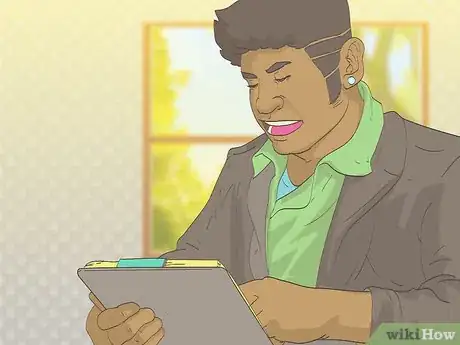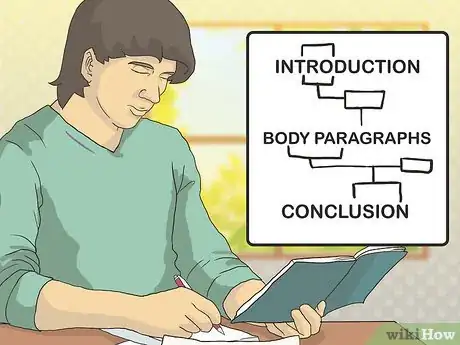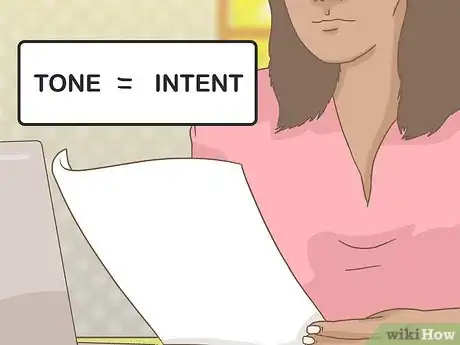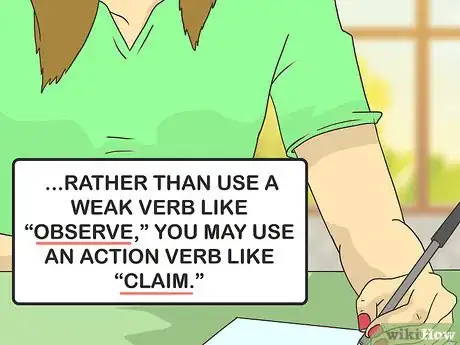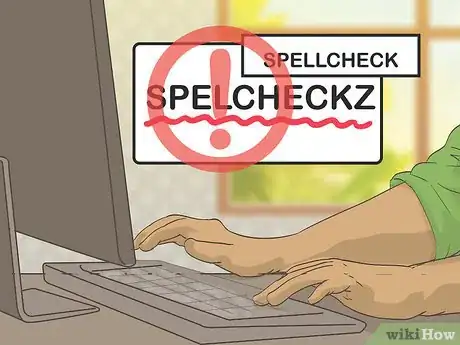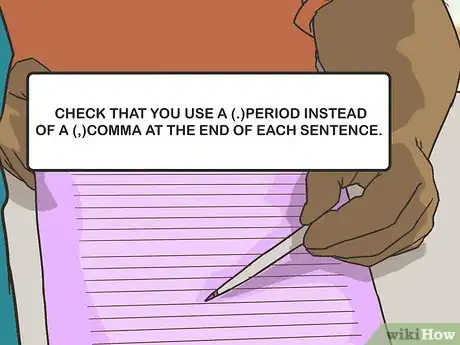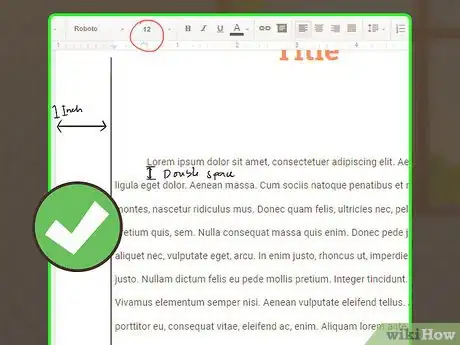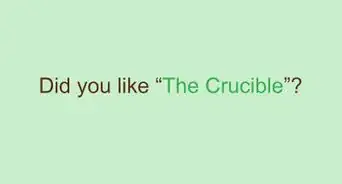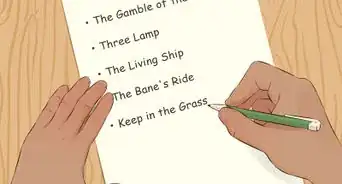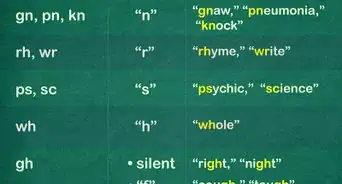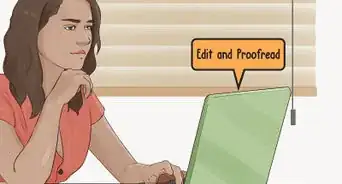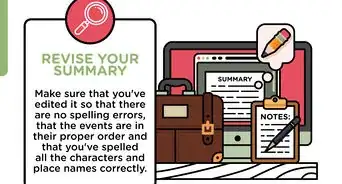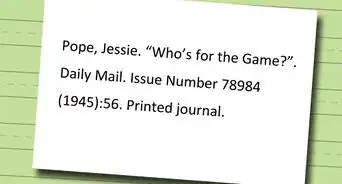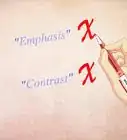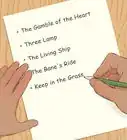This article was co-authored by Stephanie Wong Ken, MFA. Stephanie Wong Ken is a writer based in Canada. Stephanie's writing has appeared in Joyland, Catapult, Pithead Chapel, Cosmonaut's Avenue, and other publications. She holds an MFA in Fiction and Creative Writing from Portland State University.
This article has been viewed 28,490 times.
Editing a paper can feel like a daunting task, as it can be difficult to edit your own work. A well edited paper can mean the difference between a B paper and an A paper. Start by checking the paper over for structure, style, and content. You should also review the paper for spelling, grammar, and punctuation. Wrap up the editing by confirming the format of the paper is correct before you turn it in.
Steps
Checking the Structure, Style, and Content of the Paper
-
1Read over the paper several times. Start by reading the paper out loud to yourself once, and then reading the paper in your head once. Reading the paper several times will help you notice any glaring issues. It will also help you get into the mindset of editing the paper thoroughly and effectively.[1]
- If you are writing the paper on a computer, you may print out a hard copy so you can mark it up as you edit it. It may also be easier for you to read the paper aloud if you have a hard copy.
-
2Review the organization of the paper. Confirm the paper has an introduction, a conclusion, and body paragraphs. Make sure the paragraphs are arranged in a logical order, starting with the introduction, then body paragraphs, and then the conclusion.[2]
- One way you can confirm the organization of the paper to make a reverse outline of the paper. Use your paper as a guide and write out an outline that notes the introduction, body paragraphs, and conclusion sections in the paper.
Advertisement -
3Confirm the paper has a thesis statement. Most papers have a thesis statement in the introduction and again in the conclusion. You should restate the thesis statement in the conclusion with slightly different wording. The thesis statement should sum up the goal or purpose of the paper.
-
4Check the clarity of each section. Go through each section of the paper and confirm that the meaning of each section is clear. Ask yourself, does this section serve a purpose in the paper? Does it connect back to my thesis statement? Make sure the word choice and language is clear in each section. Read each section aloud and confirm the language is concise and easy to follow.[3]
- If you find any sections that appear unclear, go through them and clarify them. Replace words that are obscure or hard to follow in the section.
- You should also make sure each section begins with a transition sentence to signal to the reader you have moved on to a different point.
-
5Confirm the tone of the paper. The tone should match the intent of the paper. If you’re writing an academic paper, the tone should be formal. You may use specialized language or more complex words. If you’re writing an opinion paper, your tone may be more informal or persuasive. You may use more commonly used words or terms.[4]
- No matter what type of paper you are writing, the tone should be active through the use of the active voice in the paper, rather than the passive voice. Read through each section of the paper and change any sentences from passive voice to active voice.
-
6Look at the sentence structure and verb use in the paper. Make sure you are using sentences that are different lengths in the paper. For example, you may have one long sentence that is ten words long, followed by a sentence that is only five words long. Having sentences of varying lengths will make the paper stronger.[5]
- You should also try to use action verbs in the paper, rather than weak verbs. For example, rather than use a weak verb like “observe,” you may use an action verb like “claim.”
-
7Show the paper to someone else. Another good way to edit the paper is to show it to someone else for them to edit. Often, a fresh set of eyes on the paper will help to note any issues you missed during your editing session. Ask a peer, a friend, or a family member to read the paper for you and point out any mistakes.[6]
- If you are working on a paper for a class, you may try to trade papers with a peer for review. You can then read your peer’s paper for spelling, grammar, and punctuation. They will then do the same for you.
Reviewing the Paper for Spelling, Grammar, and Punctuation
-
1Do not rely on spellcheck. If you are writing your paper on a computer, you will have access to spellcheck, a program that checks spelling, grammar, and punctuation for you. You can use it on your paper but you should not just rely on spellcheck to edit the paper. Often, spellcheck will miss words that are spelled correctly, but used improperly.[7]
- You may run the spellcheck as a first pass over your paper for spelling, grammar, and punctuation issues. Then, do your own proofreading for these issues to catch anything that may have been missed.
-
2Review each sentence for spelling and grammar. Go through each line of text and look for any spelling or grammar mistakes. Hold a piece of blank paper over a hard copy of your paper and move it down line by line as you check the spelling and grammar of each line of text. Read each line aloud to help you catch any grammatical or spelling errors.[8]
- Watch out for common spelling errors, such as “it’s” instead of “its,” “their” instead of “there,” and “compliment” instead of “complement.”
-
3Check the punctuation in the paper. Go through the paper and circle all the punctuation. Then, make sure you are using the right punctuation in each sentence or phrase. Proper punctuation will show the reader you have an eye for detail and ensure each sentence is clear.[9]
- For example, check that you use a period instead of a comma at the end of each sentence. Confirm you use a comma between words in a sentence to break up separate ideas or objects.
-
4Read the paper backwards. One of the best ways to review the spelling, grammar, and punctuation of the paper is to read it backwards aloud. Start at the end of the paper and read each word, moving backwards through each sentence. This allows you to focus on each word and confirm it appears correctly on the page.[10]
Checking the Formatting of the Paper
-
1Confirm there are page numbers. Most instructors will require page numbers at the bottom right hand corner of the page. If there are guidelines for the paper around page numbers, make sure you follow them. You may be required to put page numbers on each page as well as your last name. This will make it easier for the instructor to find a missing page when they grade the paper.[11]
- If there is a required page or word count, check that you have the correct number of pages or words in the paper.
-
2Look at the title page and table of contents. Make sure the title page is formatted according to the requirements for the paper. Most title pages will have the title of the paper, followed by the author’s name, the date, and the title of the class. The title page format may also depend if you are following MLA, APA, or Chicago Style for the paper.[12]
- If you are required to have a table of contents in the paper, make sure it is properly formatted. You should format the table of contents using a word processor so appears professional and clean in the paper.
- Keep in mind you may not be required to have a title page or a table of contents for the paper. Check the guidelines for the paper given to you by your instructor for this information.
-
3Check the line spacing, margins, and font in the paper. Make sure you double space the paper, if required. Check that the margins follow the guidelines for the paper. 1 inch margins are the standard for most papers.You should also make sure the font is legible and use the font suggested by the instructor for the paper.
- Look at the font size to make sure it is 12 point. This is the standard size for most papers.
-
4Review the citations in the paper. Make sure all references and sources are properly cited in the paper. Use the applicable citation style based on whether you are using MLA, APA, or Chicago Style for the paper. All references in the paper must be properly cited in the text, in footnotes, or in endnotes.[13]
- You should also make sure there is a works cited or references page at the end of the paper. It should properly list all of your references or sources used in the paper.
References
- ↑ http://writingcenter.unc.edu/handouts/editing-and-proofreading/
- ↑ http://www.iun.edu/utep/docs/editing-academic-paper.pdf
- ↑ http://writingcenter.unc.edu/handouts/editing-and-proofreading/
- ↑ http://writingcenter.unc.edu/handouts/editing-and-proofreading/
- ↑ http://writingcenter.unc.edu/handouts/editing-and-proofreading/
- ↑ http://www.iun.edu/utep/docs/editing-academic-paper.pdf
- ↑ http://www.iun.edu/utep/docs/editing-academic-paper.pdf
- ↑ http://www.iun.edu/utep/docs/editing-academic-paper.pdf
- ↑ https://gustavus.edu/writingcenter/handoutdocs/editing_proofreading.php
